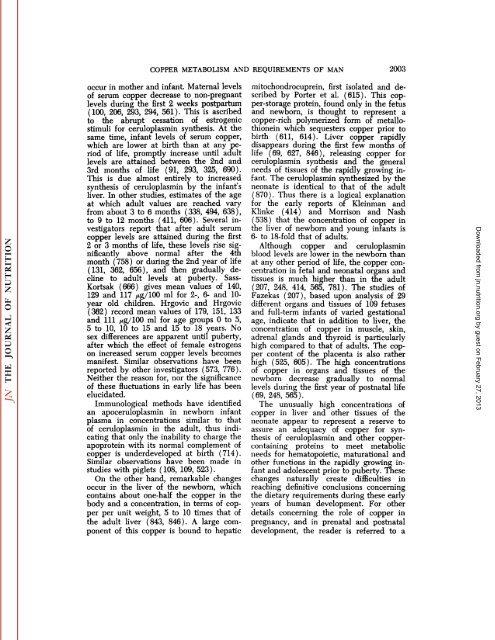conspectus of researchon copper metabolism and requirements
conspectus of researchon copper metabolism and requirements
conspectus of researchon copper metabolism and requirements
You also want an ePaper? Increase the reach of your titles
YUMPU automatically turns print PDFs into web optimized ePapers that Google loves.
COPPER METABOLISM AND REQUIREMENTS OF MAN 2003<br />
occur in mother <strong>and</strong> infant. Maternal levels<br />
<strong>of</strong> serum <strong>copper</strong> decrease to non-pregnant<br />
levels during the first 2 weeks postpartum<br />
(100, 206, 293, 294, 561). This is ascribed<br />
to the abrupt cessation <strong>of</strong> estrogenic<br />
stimuli for ceruloplasmin synthesis. At the<br />
same time, infant levels <strong>of</strong> serum <strong>copper</strong>,<br />
which are lower at birth than at any pe<br />
riod <strong>of</strong> life, promptly increase until adult<br />
levels are attained between the 2nd <strong>and</strong><br />
3rd months <strong>of</strong> life (91, 293, 325, 690).<br />
This is due almost entirely to increased<br />
synthesis <strong>of</strong> ceruloplasmin by the infant's<br />
liver. In other studies, estimates <strong>of</strong> the age<br />
at which adult values are reached vary<br />
from about 3 to 6 months (338, 494, 638),<br />
to 9 to 12 months (411, 606). Several in<br />
vestigators report that after adult serum<br />
<strong>copper</strong> levels are attained during the first<br />
2 or 3 months <strong>of</strong> life, these levels rise sig<br />
nificantly above normal after the 4th<br />
month (758 ) or during the 2nd year <strong>of</strong> life<br />
(131, 362, 656), <strong>and</strong> then gradually de<br />
cline to adult levels at puberty. Sass-<br />
Kortsak (666) gives mean values <strong>of</strong> 140,<br />
129 <strong>and</strong> 117 /¿g/100ml for 2-, 6- <strong>and</strong> 10year<br />
old children. Hrgovic <strong>and</strong> Hrgovic<br />
(362) record mean values <strong>of</strong> 179, 151, 133<br />
<strong>and</strong> 111 Mg/100 ml for age groups 0 to 5,<br />
5 to 10, 10 to 15 <strong>and</strong> 15 to 18 years. No<br />
sex differences are apparent until puberty,<br />
after which the effect <strong>of</strong> female estrogens<br />
on increased serum <strong>copper</strong> levels becomes<br />
manifest. Similar observations have been<br />
reported by other investigators (573, 776).<br />
Neither the reason for, nor the significance<br />
<strong>of</strong> these fluctuations in early life has been<br />
elucidated.<br />
Immunological methods have identified<br />
an apoceruloplasmin in newborn infant<br />
plasma in concentrations similar to that<br />
<strong>of</strong> ceruloplasmin in the adult, thus indi<br />
cating that only the inability to charge the<br />
apoprotein with its normal complement <strong>of</strong><br />
<strong>copper</strong> is underdeveloped at birth (714).<br />
Similar observations have been made in<br />
studies with piglets (108, 109, 523).<br />
On the other h<strong>and</strong>, remarkable changes<br />
occur in the liver <strong>of</strong> the newborn, which<br />
contains about one-half the <strong>copper</strong> in the<br />
body <strong>and</strong> a concentration, in terms <strong>of</strong> cop<br />
per per unit weight, 5 to 10 times that <strong>of</strong><br />
the adult liver (843, 846). A large com<br />
ponent <strong>of</strong> this <strong>copper</strong> is bound to hepatic<br />
initochondrocuprein, first isolated <strong>and</strong> de<br />
scribed by Porter et al. (615). This cop<br />
per-storage protein, found only in the fetus<br />
<strong>and</strong> newborn, is thought to represent a<br />
<strong>copper</strong>-rich polymerized form <strong>of</strong> metallothionein<br />
which sequesters <strong>copper</strong> prior to<br />
birth (611, 614). Liver <strong>copper</strong> rapidly<br />
disappears during the first few months <strong>of</strong><br />
life (69, 627, 846), releasing <strong>copper</strong> for<br />
ceruloplasmin synthesis <strong>and</strong> the general<br />
needs <strong>of</strong> tissues <strong>of</strong> the rapidly growing in<br />
fant. The ceruloplasmin synthesized by the<br />
neonate is identical to that <strong>of</strong> the adult<br />
(870). Thus there is a logical explanation<br />
for the early reports <strong>of</strong> Kleinman <strong>and</strong><br />
Klinke (414) <strong>and</strong> Morrison <strong>and</strong> Nash<br />
(538) that the concentration <strong>of</strong> <strong>copper</strong> in<br />
the liver <strong>of</strong> newborn <strong>and</strong> young infants is<br />
6- to 18-fold that <strong>of</strong> adults.<br />
Although <strong>copper</strong> <strong>and</strong> ceruloplasmin<br />
blood levels are lower in the newborn than<br />
at any other period <strong>of</strong> life, the <strong>copper</strong> con<br />
centration in fetal <strong>and</strong> neonatal organs <strong>and</strong><br />
tissues is much higher than in the adult<br />
(207, 248, 414, 565, 781). The studies <strong>of</strong><br />
Fazekas (207), based upon analysis <strong>of</strong> 29<br />
different organs <strong>and</strong> tissues <strong>of</strong> 109 fetuses<br />
<strong>and</strong> full-term infants <strong>of</strong> varied gestational<br />
age, indicate that in addition to liver, the<br />
concentration <strong>of</strong> <strong>copper</strong> in muscle, skin,<br />
adrenal gl<strong>and</strong>s <strong>and</strong> thyroid is particularly<br />
high compared to that <strong>of</strong> adults. The cop<br />
per content <strong>of</strong> the placenta is also rather<br />
high (525, 605). The high concentrations<br />
<strong>of</strong> <strong>copper</strong> in organs <strong>and</strong> tissues <strong>of</strong> the<br />
newborn decrease gradually to normal<br />
levels during the first year <strong>of</strong> postnatal life<br />
(69, 248, 565).<br />
The unusually high concentrations <strong>of</strong><br />
<strong>copper</strong> in liver <strong>and</strong> other tissues <strong>of</strong> the<br />
neonate appear to represent a reserve to<br />
assure an adequacy <strong>of</strong> <strong>copper</strong> for syn<br />
thesis <strong>of</strong> ceruloplasmin <strong>and</strong> other <strong>copper</strong>containing<br />
proteins to meet metabolic<br />
needs for hematopoietic, maturational <strong>and</strong><br />
other functions in the rapidly growing in<br />
fant <strong>and</strong> adolescent prior to puberty. These<br />
changes naturally create difficulties in<br />
reaching definitive conclusions concerning<br />
the dietary <strong>requirements</strong> during these early<br />
years <strong>of</strong> human development. For other<br />
details concerning the role <strong>of</strong> <strong>copper</strong> in<br />
pregnancy, <strong>and</strong> in prenatal <strong>and</strong> postnatal<br />
development, the reader is referred to a<br />
Downloaded from<br />
jn.nutrition.org<br />
by guest on February 27, 2013
















